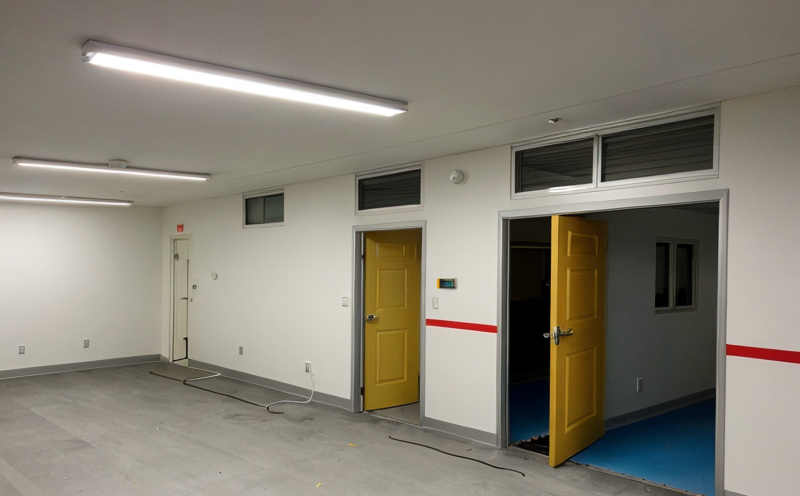ASTM G154 UV Stability Testing of Emergency Lighting Plastics
The ASTM G154 standard is widely recognized for its role in evaluating the long-term photostability of various materials, including those used in emergency lighting systems. This testing method simulates real-world exposure to ultraviolet (UV) light and heat, conditions that can lead to degradation over time.
In the context of emergency lighting, where reliability under harsh environmental conditions is paramount, ASTM G154 UV stability tests are essential. These tests help ensure that the plastics used in these systems maintain their functionality and integrity for extended periods. By subjecting specimens to accelerated aging through a combination of UV light exposure and high-temperature cycling, this testing method provides valuable insights into potential performance issues before products reach the market.
The process begins with careful selection and preparation of the plastic samples intended for emergency lighting applications. These materials must meet specific requirements regarding composition, density, color, and other physical properties to ensure they are suitable for use in such demanding environments. Once prepared, these specimens undergo rigorous testing according to ASTM G154 guidelines.
The core elements of this test include exposure chambers designed to replicate outdoor conditions using xenon arc lamps emitting UV radiation similar to that found naturally in sunlight. These chambers also incorporate temperature control systems capable of raising temperatures up to 60°C, simulating typical operating environments for emergency lighting fixtures. Over time, the samples are exposed continuously or intermittently depending on the test protocol.
After completing the prescribed duration of UV exposure combined with heat cycling, the specimens undergo detailed analysis aimed at assessing any changes in physical properties such as colorfastness, flexibility, hardness, and other relevant metrics. Changes detected during this evaluation indicate whether the plastic has degraded due to prolonged UV light contact - a critical factor for emergency lighting applications.
Results from ASTM G154 tests play an important role in quality assurance programs aimed at ensuring product reliability across various stages of development and manufacturing processes. They provide crucial data that helps manufacturers identify weaknesses early on, enabling them to make necessary adjustments before finalizing production runs or releasing new products into the market.
By incorporating ASTM G154 UV stability testing into their development cycles, companies can significantly enhance confidence in their emergency lighting solutions' ability to perform consistently under challenging conditions. This not only contributes positively towards maintaining compliance with relevant international standards but also enhances overall brand reputation among end users who rely heavily on these systems during critical situations.
Quality and Reliability Assurance
The importance of quality assurance in the manufacturing process cannot be overstated, especially when it comes to products like emergency lighting. Ensuring that every component meets stringent standards is crucial for maintaining reliability throughout its lifecycle. By integrating ASTM G154 UV stability testing into their workflows, manufacturers can significantly reduce risks associated with premature failures caused by environmental factors.
Through regular inspections and audits conducted using this standardized procedure, companies can identify potential areas of improvement in material selection or design modifications needed to enhance durability further. This proactive approach ensures that all components continue to function optimally even under extreme weather conditions.
In addition to enhancing product longevity, incorporating ASTM G154 UV stability testing also supports broader compliance efforts regarding safety regulations and industry best practices. Many jurisdictions around the world have implemented stringent requirements mandating proper testing methods for various types of lighting equipment, including emergency lighting systems. Adhering to these standards helps businesses avoid costly penalties while simultaneously building trust among consumers.
Furthermore, consistent adherence to ASTM G154 UV stability testing procedures fosters innovation within organizations by encouraging continuous improvement in both existing products and new offerings. As technology advances, so too must the materials used in emergency lighting fixtures; rigorous testing ensures that these advancements translate into safer, more effective solutions for all stakeholders involved.
International Acceptance and Recognition
The ASTM G154 UV stability test is internationally recognized and widely adopted across numerous countries. It has been endorsed by organizations such as the International Organization for Standardization (ISO), which publishes ISO 18650, and European standards bodies like CEN, who produce EN 13957-2. Additionally, IEC, another prominent global standard setter, provides guidance via its publication, IEC 60598-1.
The universality of ASTM G154 ensures that results obtained from testing emergency lighting plastics are universally applicable and accepted by regulatory authorities worldwide. This consistency facilitates smoother international trade and collaboration between manufacturers operating in different regions or exporting products globally.
Competitive Advantage and Market Impact
In today's competitive market, staying ahead of the curve is crucial for maintaining a strong foothold. By leveraging ASTM G154 UV stability testing as part of their quality assurance processes, manufacturers can gain several advantages that set them apart from competitors:
- Enhanced Product Reliability: Ensuring that emergency lighting fixtures remain operational during critical situations.
- Improved Consumer Trust: Demonstrating commitment to safety and durability through adherence to recognized standards.
- Regulatory Compliance: Avoiding potential penalties associated with non-compliance while meeting industry expectations.
- Innovation Opportunities: Encouraging continuous improvement in product design and material selection based on rigorous testing data.
Beyond these immediate benefits, incorporating ASTM G154 UV stability testing into your workflow can have long-term effects that positively influence market positioning. As consumer awareness grows regarding the importance of reliable emergency lighting solutions, brands that prioritize quality through such measures will naturally attract more customers seeking dependable products.





